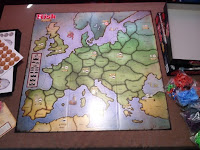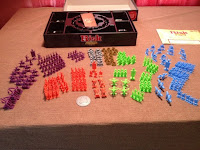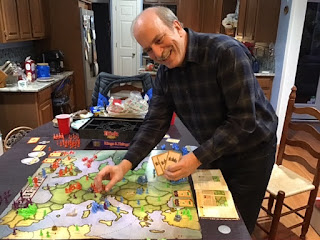Happy New Year, or, I Resolve to Conquer Europe
Welcome to a New Year and the return of my blog! To kick off 2020 A.D., a few gaming buddies and I decided to go back a thousand years or so to those giddy, happy days of 1020 A.D. (or thereabouts) and do what everybody did back then to celebrate the turning of the year— conquer their neighbors! (Hey, when you don’t have fireworks, you gotta find another way to make some noise.)
Our game of choice this evening: Risk: Europe.
 |
| Ooo! Flaming catapults! (Actual fire not included.) |
This game entered my collection a couple of years ago, but this was the first time it made it to our tabletop. I had only ever read the rules, so none of us had any experience with the game. This evening would be a baptism in fire for everyone!
Europe On One Silver Coin a Day
 |
| Medieval Europe, or a Reasonable Facsimile Thereof |
It’s time for a lightning tour of Europe. As you can see, the map lists various medieval kingdoms and fiefdoms, as well as the standard dashed-line “sea lanes.” New to Risk gamers will be the cities (indicated by a white circle with a crown) and capitals (white circle with shiny gold border and gold crown). Each city also shows a number, ranging from 2 to 4. You will note there are no “continents”, nor the classic “continent bonus” chart. Instead there is a chart showing various numbers of crowns, and Roman numerals ranging from V to VII, then in red VIII to X. Curious, indeed!
 |
| The armies of Europe. Plus crowns. |
Also included are a number of plastic gold crowns (equal to the number of cities), a silver plastic First Player token, some gray plastic castles, cardboard silver and gold coins, several cardboard shields bearing the name of each of the capitals and some special text, a deck of cards, and a lot of dice— more than your typical Risk game. But what stands out are the inhabitants of this medieval world— rather than the typical Risk game where all the forces are identical figures, these differ not only in color, but with designs unique to each color. The figures represent a (somewhat fanciful) military force from the Middle Ages, divided into Footmen, Archers, Cavalry, and Siege Engines.
As may be evident, Risk: Europe is a considerable departure from the Risk franchise. Although conquest is indeed part of the game, commanding the entire map isn’t the goal, nor is it even likely. Everything from units to turn decisions to combat are substantially changed from anything Risk players are used to—which of course alters strategies in radical ways.
 |
| Siege Engine awesomeness, from left to right: The mighty catapult, the powerful sling trebuchet, the deadly spear-throwing ballista, and... three guys with a log. |
It’s All About the Crowns, Baby
The goal of Risk: Europe isn’t to conquer the world— it’s to acquire crowns. The first player to collect seven crowns and hold them at the end of a round (more on that in a moment) wins the game. You collect crowns by conquering cities and capitals, but you may also purchase the crowns (in the basic game), or achieve crowns by completing secret “Kingdom Missions” (in the advanced game). So the objectives to your goal are two-fold— claim cities and/or amass coins to purchase crowns. But there’s more to it than that.
The Medieval Round
The game is divided into rounds, during which each player issues two orders (and only two orders). Each player will issue one order, one at a time, going around the table. Doing this twice around the table is a round. At the end of the round if any battles are possible, these are resolved. At that point if a player holds 7 or more crowns, the game is over.
Your Orders, My Liege?
The orders are not a simple set of options as in standard Risk; you do not simply place forces and decide where and when to attack. Instead, each player has a deck of 8 cards with specific orders written on each card. The orders on the cards are divided into two choices. For example, a card may read “Tax” on the top half and “Spend” on the bottom. When the card is played, the player may choose to do only one of these orders— either tax his cities to collect coins, or spend his coins for troops, castles, or crowns; he cannot do both. Some of the cards also contain special actions that occur no matter which choice is made. Each round begins with all of the players secretly selecting two order cards to use and placing these on the table face down. The top card will contain a player’s first order of the round, the bottom card the second. Once the cards are played and the order chosen, the cards are discarded, leaving the player with two fewer cards to choose from, and so on. Once all cards are discarded (equaling four rounds), the players begin again with their full decks.
The cards control troop movements, and limit them as well. At most a player will only ever be in a position to attack four territories in a single round, and that only if they play two specific cards back to back (and there are only two of these cards in each deck). Also, since two cards (and thus two orders) will be played by every player before any battles are resolved, it’s possible that a player could reinforce his army in a disputed territory before the battle happens. Keeping track of which cards your opponents have played is an important strategic element in the game!
As a result of these cards, a player will be forced to decide if and when he will collect coins, if and when he will buy forces (and which ones), and if and when he will advance against the enemy or reinforce threatened territories— you may end up able to do any two of these in a round, but never all of them, and as cards are used, some actions will no longer be available until the decks reset.
First Rank...Volley!
Combat takes a distinct change from Risk in that the actual unit types matter— they aren’t stand-ins for amounts, but behave as the troop types they actually are, to a limited degree. (This is somewhat similar to the classic MB/Eagle Games Conquest of the Empire.) In Risk: Europe combat is broken down into four “Ranks,” which occur in order. First, Siege Engines get an attack, forcing the opponent to remove troops for all hits rolled (for a Siege Engine, any result of 3 or better on each die rolled). Then Archers attack, followed by Cavalry. A player may only use such troops as are in the specific battle— for example, if Green has no Archers in the battle, he does nothing during the Archer Rank action, except potentially lose troops. Once all three of these attacks occur, all of the forces (including those which just attacked) are counted up, and a final general attack is rolled using the same dice rules as standard Risk (in this instance all of the units participate, even if they attacked as part of a previous Rank). Then the Ranks begin again, the entire procedure continuing until one side or the other (or even possibly both) are eliminated from the territory— that’s right there are no retreats in Risk: Europe! It’s do or die for your troops!
Castles allow for the defender in the territory to re-roll any and all Rank results— but the defender must re-roll all the dice, including successful hits, and replace these with the second roll results, even if worse. (So if you have one hit and two misses, do you re-roll all three in hopes of getting more hits, at the risk of having none, or keep your single hit?)
Not-Risk Risk
You will note that unlike standard Risk:
- There are no territory cards. None at all.
- The game will not begin with all territories occupied. In fact, most territories will likely never be occupied in the game.
- There are no bonus continent/region reinforcements, or per territory reinforcements. In fact, the number of territories controlled is irrelevant to the number of troops in play. Only cities and capitals matter, as they can be taxed for coins.
- An entire round can go by with no one attacking anyone, but expansion and maneuvering still occurring.
- Engaging in battle is deadly. You either win, or you lose all your men in the battle— that’s right, all of them. No retreat, no surrender, and no quarter!
In Which Our Heroes Play Game 1, or, Whoa, That Was Fast
 |
| So, after one round, no combat, but... |
 |
| Money to spend = Money to win |
Once More, With Feeling, or, The Long(ish) Game
 |
| Once more into the breach! |
 |
| Actual combat! Hooray! |
 |
| Hail Good King Will! |
Worth the Coin?
While we did have fun, our two plays ended with the jury undecided. Overall we enjoyed the game, but none of us really had a good feel for how it would play out over the long haul. Our play went very slowly, taking more time than was truly necessary to resolved each round. But I believe that had more to do with our unfamiliarity with the rules. We just weren’t quite certain how to proceed, which left a lot of musing over card and order choice. I suspect as we grow more confident in our understanding of how the game works, the play will be quicker and more dramatic. It’s clear that this is a game where the fun comes when you take risks worthy of the game’s name. However, it allows for play that is cautious and even non-combative, which can be a dull way to go about things. Still, we’re all willing to give it another go, and that’s a good sign.
Final assessment: An interesting— if not entirely Risk-like— variation on Risk. The thematic flavor is spot on and the components are largely well done (the cardboard coins are a bit boring, but the figures and their variety make up for that). The combat system may be my favorite element— having the troops act as what they represent is an enjoyable twist on the classic Risk approach to battles, and “feels right” in a medieval setting. I also thought that the limited maneuver and expansion choices fit the history of warfare in the Middle Ages, as did the brutal battle results!
Although the game claims to be for 2 to 4 players, with 4 players we still found it a little too easy to avoid conflict (as evidenced in Game 1). There are rule adjustments for fewer players (one neutral force becomes “mercenaries”), but I think the full 4 -player complement is probably the best bet for an enjoyable game, provided players lean a little more toward aggressive action than combat avoidance.
Overall, this hasn’t leaped to the top of my favored Risk variants. However, that reaction may be more because in so many ways this game is really not Risk, but something different. I do look forward to seeing how that difference plays out as it hits the tabletop again.
Until my next entry, Happy New Year, and Happy Gaming!
Parzival, the Wargamesmonger
